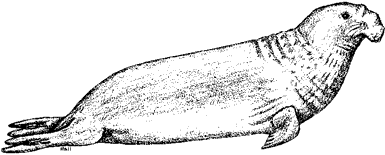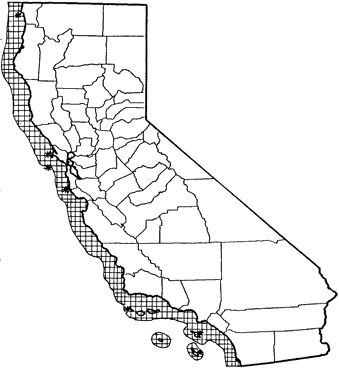
Northern Elephant Seal
Distribution, Abundance, and Seasonality
Occur in pelagic waters along the coast and abundant on California islands. Following intensive commercial exploitation in mid-1700's to late-1800's, and subsequent near extinction, recolonized islands in California in the 1930's, and began to breed on San Miguel Island. Today more than 30,000 live along the coast of California, and population continues to expand (Le Boeuf 1977, Le Boeuf and Bonnell 1980, Bonnell and Pierson 1981). Breed in winter in dense rookeries on Channel Islands, Southeast Farallon Island, A–o Nuevo Island, on mainland at A–o Nuevo (San Mateo Co.), and at an isolated cove along Big Sur coast. From April to November feed at sea or haul out to molt at rookeries.

Range Map
Specific Habitat Requirements
Feeding: Varied diet. Feed mainly on rays, sharks, pelagic squid, ratfish, and Pacific hake, all found in deep water (Morejohn and Baltz 1970, Antonelis and Fiscus 1980). In total, 30 species have been identified as prey items (Condit and Le Boeuf 1984). Appear to be pelagic, principally nocturnal predators that prefer to prey on abundant, schooling cephalopods and fishes. Generally appear to feed in deep water at a minimum depth of 200 m (656 ft) (McGinnis and Shusterman 1981, Condit and Le Boeuf 1984). Capable of diving to much greater depths for long periods of time.
Cover: Usually observed singly at sea; on land, occur in dense aggregations of up to hundreds during breeding and molting seasons.
Reproduction: All breeding activities take place on isolated or protected beaches on islands, or at a few mainland sites. Preferred breeding areas are located on beaches protected from effects of severe winter storms and high surf (Riedman and Le Boeuf 1982). Parturient females in small, newly established breeding colonies are especially sensitive to human disturbance. Philopatric; return to birthsite to breed and molt.
Water: Water oxidatively produced from fat stores during long periods of fasting on land (Ortiz et al. 1978).
Pattern: Prefer isolated or protected beaches. Both sexes fast during breeding and molting.
Species Life History
Activity Patterns: Active yearlong; circadian pattern at haul-out sites.
Seasonal Movements / Migration: Seasonal variations in abundance of sex and age classes present in rookeries. Annual cycle consists of spring molt for juveniles and females, summer molt for males, fall haul-out for juveniles, and winter breeding (Le Boeuf 1981). Annual summer and winter northward migration of juveniles of both sexes occurs. Northward movement of adult males in spring and fall also occurs (Condit and Le Boeuf 1981, 1984).
Home Range: No information found.
Territory: None maintained.
Reproduction: Breed from mid-December into March. Highly polygynous. Adult males form dominance hierarchies. A high-ranking male may sire hundreds of pups in a lifetime; however, the majority of males do not mate, and produce no offspring (Le Boeuf 1974). Breeding colonies consist of harems containing a few to hundreds of females and pups, controlled by 1 or more bulls. During breeding season, males fast for 3 mo. Females fast for 5 wk and nurse their single pup for 4 wk; in last few days of lactation, females come into estrus and mate (Le Boeuf et al. 1972). Gestation is about 11 mo, with a delayed implantation period of 3 mo. Pups weaned abruptly and fast about 2 mo before departing for sea. Lifetime reproductive potential of a female is about 10 pups (Reiter et al. 1980).
Niche: Great white sharks prey on all age classes (Le Boeuf et al. 1982). Seal placentas and decomposing carcasses provide food for marine organisms, especially gulls. Seawater surrounding seal rookeries is enriched with nitrogen compounds from waste products, which enhance algal growth, producing additional food for intertidal fishes and seabirds (Le Boeuf and Kaza 1981).
Sources & References
California Department of Fish and Game, 1999.
California's Wildlife, Sacramento, CA.
Written by: M. L. Riedman, reviewed by: H. Shellhammer, edited by: J. Harris, R. Duke
Antonelis, G. A., and C. H. Fiscus. 1980. The pinnipeds of the California current. Calif. Coop. Oceanic Fish. Invest. Rep. 21:68-78. Bonnell, M. L., and M. O. Pierson. 1981. Seasonal abundance of pinnipeds on the islands and mainland shore of California. Page 11 in Procs. Fourth Biennial Conf. on the Biology of Marine Mammals, San Francisco. 127pp. Condit, R., and B. J. Le Boeuf. 1981. Pelagic distribution of the northern elephant seal, Mirounga angustirostris. Page 18 (abstract) in Proc. of the fourth biennial conf. on the biology of marine mammals, San Francisco, Calif. 127pp. Condit, R., and B. J. Le Boeuf. 1984. Feeding habits and feeding grounds of the northern elephant seal. J. Mammal. 65:281-290. Le Boeuf, B. J. 1974. Male-male competition and reproductive success in elephant seals. Amer. Zool. 14:163-176. Le Boeuf, B. J. 1977. Back from extinction? Pac. Discovery 30:1-9. Le Boeuf, B. J. 1981. Mammals. Pages 187-325 in B. J. Le Boeuf and S. Kaza, eds. The natural history of Ano Nuevo. Boxwood Press, Pacific Grove, Ca. 425pp. Le Boeuf, B. J., and M. L. Bonnell. 1980. Pinnipeds of the California islands: abundance and distribution. Pages 475-493 in D. Power, ed. The California islands. Santa Barbara Mus. Nat. Hist. 787pp. Le Boeuf, B. J., and S. Kaza, eds. 1981. The natural history of Ano Nuevo. Boxwood Press, Pacific Grove, Ca. 425pp. Le Boeuf, B. J., M. L. Riedman, and R. S. Keyes. 1982. White shark predation on pinnipeds in California coastal waters. Fish. Bull. 80:891-895. Le Boeuf, B. J., R. J. Whiting, and R. F. Gantt. 1972. Perinatal behavior of northern elephant seal females and their young. Behavior 43:121-156. McGinnis, S. M., and R. J. Shusterman. 1981. Northern elephant seal, Mirounga angustirostris. Pages 329-349 in S. H. Ridgeway and R. J. Harrison, eds. Handbook of marine mammals, Vol. 2. Academic Press, London. 359pp. Morejohn, G. V., and D. M. Baltz. 1970. Contents of the stomach of an elephant seal. J. Mammal. 51:173-174. Ortiz, C. L., D. Costa, and B. J. Le Boeuf. 1978. Water and energy flux in elephant seal pups fasting under natural conditions. Physiol. Zool. 51:166-178. Reiter, J., K. J. Panken, and B. J. Le Boeuf. 1980. Female competition and reproductive success in northern elephant seals. Anim. Behav. 29:670-687. Riedman, M. L., and B. J. Le Boeuf. 1982. Mother-pup separation and adoption in northern elephant seals. Behav. Ecol. Sociobiol. 11:203-215.
California Animal Facts | California's Wildlife